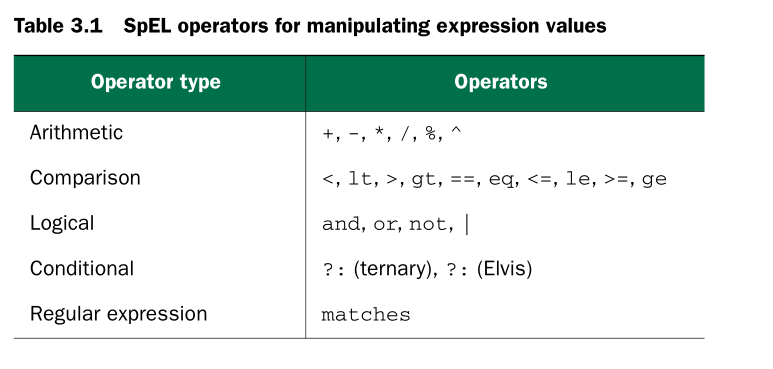一、
1.SpEL expressions are framed with #{ ... }
2.SpEl的作用
Sp EL has a lot of tricks up its sleeves, including the following:
The ability to reference beans by their ID s
Invoking methods and accessing properties on objects
Mathematical, relational, and logical operations on values
Regular expression matching
Collection manipulation
As you’ll see later in this book, S p EL can also be used for purposes other than depen-
dency injection. Spring Security, for example, supports defining security constraints
using S p EL expressions. And if you’re using Thymeleaf templates as the views in your
Spring MVC application, those templates can use S p EL expressions to reference
model data.
3.基础例子
(1)解析原始类型数据 #{1}
(2)解析java类的静态方法#{T(System).currentTimeMillis()},"T()"会把被包括的内容解析为java类
(3)解析bean:#{sgtPeppers.artist},取出id为“sgtPeppers”的artist属性
(4)解析properties:#{systemProperties['disc.title']}
二、进一步了解SpEl
1.EXPRESSING LITERAL VALUES
(1)浮点型:#{3.14159}
(2)科学计数法:#{9.87E4} PS:=98,700
(3)字符串:#{'Hello'}
(4)布尔型:#{false}
2.REFERENCING BEANS , PROPERTIES , AND METHODS
(1)引用bean:#{sgtPeppers} (in this case, a bean whose ID is sgtPeppers )
(2)引用bean的属性:#{sgtPeppers.artist} 引用id为"sgtPeppers"的bean的artist属性
(3)调用bean的方法:#{artistSelector.selectArtist()}
(4)链式调用:#{artistSelector.selectArtist().toUpperCase()}
(5)防止空指针:#{artistSelector.selectArtist()?.toUpperCase()}
3.WORKING WITH TYPES IN EXPRESSIONS
The key to working with class-scoped methods and constants in S p EL is to use the T()
operator. For example, to express Java’s Math class in S p EL , you need to use the T()
operator like this:
T(java.lang.Math)
The result of the T() operator, as shown here, is a Class object that represents java.lang.Math .
(1)T(java.lang.Math).PI
(2)T(java.lang.Math).random() random value between 0 and 1:

(1)计算一个代表圆的bean的周长:#{2 * T(java.lang.Math).PI * circle.radius}
(2)计算面积:#{T(java.lang.Math).PI * circle.radius ^ 2}
(3)用"+"连接字符串:#{disc.title + ' by ' + disc.artist}
(4)符号逻辑和文本逻辑操作符是等效的:#{counter.total == 100} 或者 #{counter.total eq 100}
(5)三目运算符:#{scoreboard.score > 1000 ? "Winner!" : "Loser"}
设置默认值:#{disc.title ?: 'Rattle and Hum'}
4.EVALUATING REGULAR EXPRESSIONS
(1)验证邮箱(不全) :#{admin.email matches '[a-zA-Z0-9._%+-]+@[a-zA-Z0-9.-]+\.com'}
5.EVALUATING COLLECTIONS
(1)#{jukebox.songs[4].title}
(2)随机播放歌曲:#{jukebox.songs[T(java.lang.Math).random() *jukebox.songs.size()].title}
(3)"[]"也可用来从字符串中截取字符:#{'This is a test'[3]} ,返回's'
(4)筛选:#{jukebox.songs.?[artist eq 'Aerosmith']},会返回所有Aerosmith的歌曲的新集合
(5)SpEL also offers two other selection operations: .^[] for selecting the first matching entry and .$[] for selecting the last matching entry.
返回第一个符合条件的条目:#{jukebox.songs.^[artist eq 'Aerosmith']}
(6)投影:SpEL offers a projection operator ( .![] ) to project properties from the elements in the collection onto a new collection.
抽取所有title:#{jukebox.songs.![title]}
组合操作,获取Aerosmith的所有歌名:#{jukebox.songs.?[artist eq 'Aerosmith'].![title]}